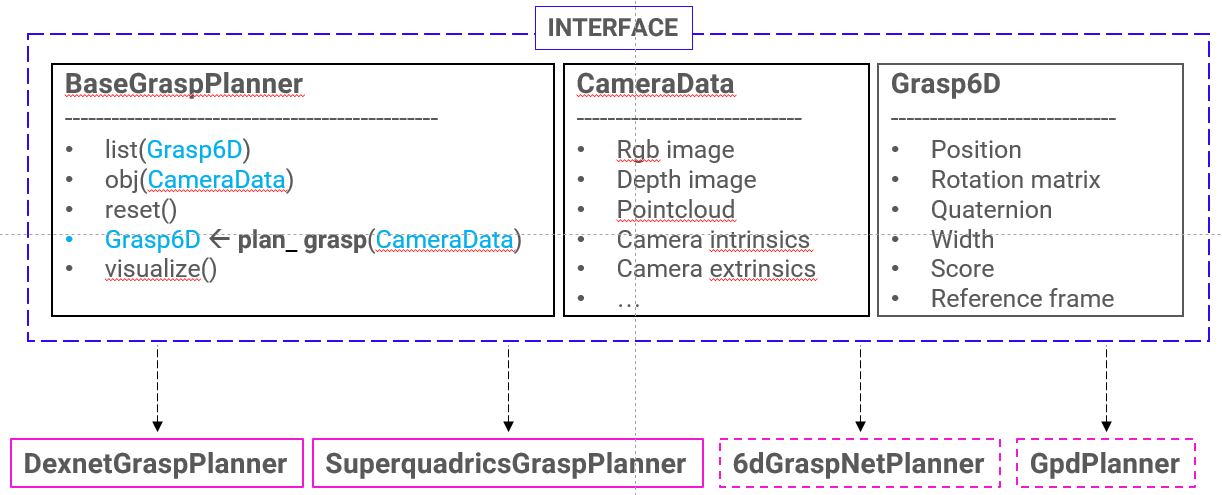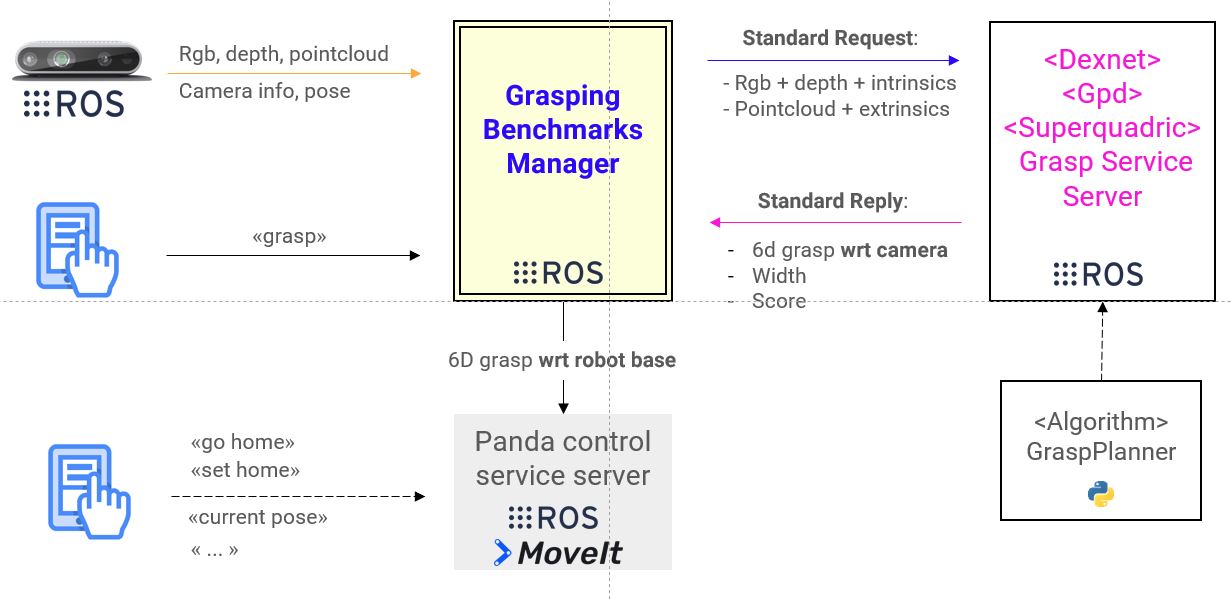In robotics, it is often useful to try different grasp planners on the same task. At any given time, simply looking at the most promising and cited approaches brings up a good handful of well-performing pieces of work. Users might want to try out a few of these for different purposes, for instance benchmarking or finding the best performing approach for a specific task. Grasping pipelines are, however, usually quite articulated and complex and users will find themselves knee-deep in a puddle of missing dependencies, lack of interface standardization and middleware support.
- In a nutshell
- Contents of this repo
- Installation
- Python framework description
- Grasping Benchmarks Ros Description
This repo simply tries to address the needs of users looking for some help in setting up popular grasp planning approaches. It offers a framework to benchmark different robotic grasp planning algorithms under a common interface. It is designed to work with both a simulated and real Franka Emika Panda, because that's what we have currently in our setup (hence the repo and organization name).
It is composed of 3 main modules:
- grasping_benchmarks: a python package that provides the base interface for the grasp planners and a class for each supported algorithm
- grasping_benchmarks_ros: a ROS-based framework that allows to benchmark the grasp planners on the robotic platform. It is supposed to wrap around the previous module
- docker: a collection of docker images, one for each supported grasp planner, including
- the algorithm implementation within the
grasping_benchmarksinterface, typically in Python - the algorithm implementation within the ROS wrapper, typically in Python/C++
- all the dependencies, compiled and installed
- the ROS benchmark manager.
- the algorithm implementation within the
So far, this repo includes support for:
| Algorithm | Documentation | Paper |
|---|---|---|
| Dexnet | docs | paper |
| GPD | docs | paper |
| Superquadrics-based grasp planner | docs | paper |
| 6DoF-GraspNet | docs [original repo] | paper |
We only use Python3 here.
Follow these instructions if you want to install only the python package without the ROS framework.
-
Clone the repository:
$ git clone https://github.com/hsp-panda/grasping-benchmarks-panda.git
-
Install the package in editable mode:
$ cd grasping-benchmarks-panda $ pip3 install -e .
-
Test the installation with:
import grasping_benchmarks help(grasping_benchmarks)
Follow these instructions if you want to install also the ROS 1 (no ROS2 yet, sorry) framework. In order to install and use this module, you need to include it in a catkin workspace.
-
Install python3 ROS packages:
$ sudo apt update $ sudo apt install python3-catkin-pkg-modules python3-rospkg-modules python3-empy -
Create a catkin workspace:
$ mkdir -p ~/catkin_ws/src $ cd catkin_ws $ wstool init
-
Add to the catkin workspace some ROS dependencies to be built with python3:
$ wstool set -y src/geometry2 --git https://github.com/ros/geometry2 -v 0.6.5 $ wstool set -y src/vision_opencv --git https://github.com/ros-perception/vision_opencv -v 1.13.0 $ wstool set -y src/ros_numpy https://github.com/eric-wieser/ros_numpy $ wstool up
-
Clone the repository:
$ wstool set -y src/grasping-benchmarks-panda --git https://github.com/hsp-panda/grasping-benchmarks-panda $ wstool up -
Install the package in editable mode:
$ cd src/grasping-benchmarks-panda $ pip3 install -e .
-
Install the dependencies of the algorithm you want to benchmark. You can follow the instructions provided by the authors of each algorithm, or you can take a look at the Docker recipes and see how we did it ourselves. The currently supported algorithms are:
- Dexnet:You need to install gqcnn
- GPD: Follow gpd
- Superquadrics-based grasp planner: Follow superquadric-lib. Note that you need to compile the python bindings.
- 6DoF-GraspNet: We used this PyTorch implementation.
-
You will need a package to move the robot and execute motion primitives such as movement and grasps. We do this with ROS and the MoveIt! stack. If you use ROS, you can borrow our stuff. You will need a Python2 catkin workspace and a MoveIt! installation where to compile the panda_grasp_server + panda_ros_common packages. If you use different tools and/or middlewares (e.g. YARP) you are going to have to write your own.
-
Build the catkin workspace:
$ cd ~/catkin_ws # Set -DGPD_ROS=ON if you want to benchmark GPD $ catkin config --extend /opt/ros/melodic -DPYTHON_EXECUTABLE=/usr/bin/python3 -DCMAKE_BUILD_TYPE=Release -DGPD_ROS=OFF $ catkin build $ source devel/setup.bash $ echo 'source ~/catkin_ws/devel/setup.bash' >> ~/.bashrc
If you don't want to bother with manually setting everything up, we advise using our Docker images. We prepared one for each supported algorithm with everything already in place (except the motion planner, for now). You can build the Docker image for the approach of your choosing. If you are not familiar with Docker, see here. Install it. Afterwards:
-
Clone the repository:
$ git clone https://github.com/hsp-panda/grasping-benchmarks-panda.git $ cd grasping-benchmarks-panda/docker -
Use the Makefile to build an image of your choosing:
$ cd build_images $ make USER_NAME=<docker_image_user_name> <target>
targets dexnet gpd superquadrics 6dgraspnet -
[Optional] There are also two additional docker images that can be built, one with development tools such as qtcreator and atom (tools/) and another one with the Franka Panda libraries such as franka-ros and moveit (panda_deps/). These images are intended to provide additional features to the images compiled at point 2.
To create the quintessential grasping suite, you can use docker-compose. An example script is provided in /docker/build_images/docker-compose.yaml.
The grasping_benchmark Python package follows the structure shown in the figure below.
The code of the interface is inside the directory base/. It provides:
- BaseGraspPlanner: the base image that should be inherited by the
<algorithm>GraspPlannerclasses. The principal feature of this class is theplan_grasp()method, which takes as input an object of typeCameraDataand returns the grasp pose as an object of typeGrasp6D. - CameraData: a class that needs to be filled with the camera data necessary to compute a grasp candidate.
- Grasp6D: a class that contains the info of the grasp candidate computed by the algorithm.
- Transformations: it is provided also a bunch of functions to compute rotation transformations.
Each algorithm that inherits from the BaseGraspPlanner interface needs to:
- fill the
plan_grasp()method with the code to compute the grasp poses - provide a
create_camera_data()method that fills theCameraDataobject in the proper format required by the specific algorithm. - fill the
visualize()method with the code to visualize the grasp purposes - eventually extend the
reset()method.
The python package can be imported in any python code as:
import grasping_benchmarksThe grasping benchmark ros framework follows the structure shown in the figure below.
It is the main actor of the framework, connecting the different modules and sending data to the robot control module.
- It reads the data sent by a Realsense camera through the ros module IntelRealSense/realsense-ros. The subscribed topics are:
/camera/color/image_raw: rgb image/camera/aligned_depth_to_color/image_raw: aligned depth/camera/depth_registered/points: point cloud. In case you wish to use a segmented point cloud instead of the camera feed, you must remap this.
It also reads the camera pose wrt the robot base that should be part of the TF ROS tree. If this is not already taken care in your code, you can simply add it with the rosrun tf static_transform_publisher command. For instance, you can add a transform from the /panda_EE frame to the /camera_link frame:
bash $ rosrun tf static_transform_publisher 0.047 -0.03496 -0.08288 0.008 -1.506 3.14 /panda_EE /camera_link 50
These values here are strictly relative to our own camera mount, yours will be different and will have to be obtained through a hand-eye calibration.
- It receives also a few commands from a user through a
user_cmd_service. Available commands are:
help: list of available commandsgrasp: computes a new graspabort: abort the grasp computation/execution in case a bad grasp pose is computed
-
It connects with the algorithm service server. It sends the camera data and receives the candidate grasp.
The service type implemented by the algorithm service server should chosen among the standard services provided, depending on the type of data required by the grasp planning algorithm:
Each service returns a msg/BenchmarkGrasp.msg.
-
Finally it connects with the Panda Control service server. It sends the grasp pose as a
geometry_msgs/PoseStampedmessage. The Panda Control service server executes the grasp and return the failure/succes of the grasp.
-
Launch your robot control and motion planning stack (or just use our primitive handling server, it's free!)
-
(Optional) If you are using the Docker images, spinning up the images require a bunch of additional arguments and flags in addition to the
docker run/docker startcommands. We provide this as a comfyrun.shscript. Assuming you wish to run the image containing algorithmALGORITHM_NAMEasUSER, you can execute
./run.sh $USER ${ALGORITHM_NAME}-container ${USER}/benchmark_${ALGORITHM_NAME}
In case ${ALGORITHM_NAME}-container already exists (e.g. you simply want to open another shell in it), you can just use
./run.sh $USER ${ALGORITHM_NAME}-container
- Run the benchmarks framework.
-
You may need to set the correct paths to the models/config files in grasping_benchmarks_ros/launch/grasp_planning_benchmark.launch
-
Specify the name of the algorithm to set up:
$ roslaunch grasping_benchmarks_ros grasp_planning_benchmark.launch realsense:=false <target>:=truetargets dexnet gpd superquadrics graspnet -
Send commands to the service
/<target>_bench/user_cmd. For example, to get a list of available commands:$ rosservice call /dexnet_bench/user_cmd "cmd: {data: 'help'}" Available commands are: help: display available commands grasp: compute a new grasp and send it to the robot for execution get_candidates [n]: computes n candidates and saves them to file abort: interrupt grasp computation / do not send computed pose to the robot -
Or, to grasp:
$ rosservice call /dexnet_bench/user_cmd "cmd: {data: 'grasp'}"Watch it go and/or brace for impact 😛
-
This repository is maintained by:
| @fbottarel |

